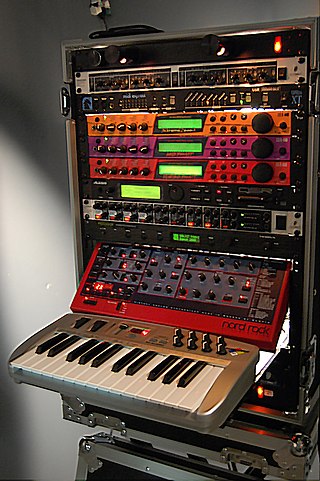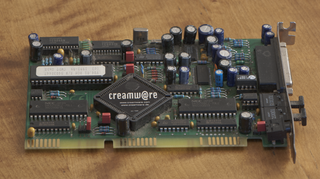
MIDI is a technical standard that describes a communication protocol, digital interface, and electrical connectors that connect a wide variety of electronic musical instruments, computers, and related audio devices for playing, editing, and recording music.

AVR is a family of microcontrollers developed since 1996 by Atmel, acquired by Microchip Technology in 2016. These are modified Harvard architecture 8-bit RISC single-chip microcontrollers. AVR was one of the first microcontroller families to use on-chip flash memory for program storage, as opposed to one-time programmable ROM, EPROM, or EEPROM used by other microcontrollers at the time.
Open Sound Control (OSC) is a protocol for networking sound synthesizers, computers, and other multimedia devices for purposes such as musical performance or show control. OSC's advantages include interoperability, accuracy, flexibility and enhanced organization and documentation. Its disadvantages include inefficient coding of information, increased load on embedded processors, and lack of standardized messages/interoperability. The first specification was released in March 2002.
Steinberg Media Technologies GmbH is a German musical software and hardware company based in Hamburg. It develops music writing, recording, arranging, and editing software, most notably Cubase, Nuendo, and Dorico. It also designs audio and MIDI hardware interfaces, controllers, and iOS/Android music apps including Cubasis. Steinberg created several industry standard music technologies including the Virtual Studio Technology (VST) format for plug-ins and the ASIO protocol. Steinberg has been a wholly owned subsidiary of Yamaha since 2005.

Virtual Studio Technology (VST) is an audio plug-in software interface that integrates software synthesizers and effects units into digital audio workstations. VST and similar technologies use digital signal processing to simulate traditional recording studio hardware in software. Thousands of plugins exist, both commercial and freeware, and many audio applications support VST under license from its creator, Steinberg.

Pro Tools is a digital audio workstation (DAW) developed and released by Avid Technology for Microsoft Windows and macOS. It is used for music creation and production, sound for picture and, more generally, sound recording, editing, and mastering processes.

A digital audio workstation is an electronic device or application software used for recording, editing and producing audio files. DAWs come in a wide variety of configurations from a single software program on a laptop, to an integrated stand-alone unit, all the way to a highly complex configuration of numerous components controlled by a central computer. Regardless of configuration, modern DAWs have a central interface that allows the user to alter and mix multiple recordings and tracks into a final produced piece.

The Atari Falcon030, released in 1992, is the final personal computer from Atari Corporation. A high-end model of the Atari ST line, the machine is based on a Motorola 68030 CPU and a Motorola 56001 digital signal processor, which distinguishes it from most other microcomputers of the era. It includes a new VIDEL programmable graphics system which greatly improves graphics capabilities.

Novation Digital Music Systems Ltd. is a British musical equipment manufacturer, founded in 1992 by Ian Jannaway and Mark Thompson as Novation Electronic Music Systems. Today the company specializes in MIDI controllers with and without keyboards, both analog and virtual analog performance synthesizers, grid-based performance controllers, and audio interfaces. At present, Novation products are primarily manufactured in China.

The Blackfin is a family of 16-/32-bit microprocessors developed, manufactured and marketed by Analog Devices. The processors have built-in, fixed-point digital signal processor (DSP) functionality supplied by 16-bit multiply–accumulates (MACs), accompanied on-chip by a microcontroller. It was designed for a unified low-power processor architecture that can run operating systems while simultaneously handling complex numeric tasks such as real-time H.264 video encoding.
Nios II is a 32-bit embedded processor architecture designed specifically for the Altera family of field-programmable gate array (FPGA) integrated circuits. Nios II incorporates many enhancements over the original Nios architecture, making it more suitable for a wider range of embedded computing applications, from digital signal processing (DSP) to system-control.

The Nord Modular series is a line of synthesizers produced by Clavia, a Swedish digital synthesizer manufacturer. The Nord Modular series, in common with their sister range the Nord Lead series, are analogue modelling synthesizers, producing sounds that approximate those produced by conventional analogue synths by using DSP chips to digitally model analogue circuitry.

The Sound Blaster 16 is a series of sound cards by Creative Technology, first released in June 1992 for PCs with an ISA or PCI slot. It was the successor to the Sound Blaster Pro series of sound cards and introduced CD-quality digital audio to the Sound Blaster line. For optional wavetable synthesis, the Sound Blaster 16 also added an expansion-header for add-on MIDI-daughterboards, called a Wave Blaster connector, and a game port for optional connection with external MIDI sound modules.

The Parallax P8X32A Propeller is a multi-core processor parallel computer architecture microcontroller chip with eight 32-bit reduced instruction set computer (RISC) central processing unit (CPU) cores. Introduced in 2006, it is designed and sold by Parallax, Inc.

SynthEdit is a modular audio plugin development environment which uses a visual editor. First conceived in 1987 by programmer Jeff McClintock and initially distributed in 1999, it was officially released in 2005.
MIDIbox is a non-commercial open source project with a series of guides on how to build musical instrument device interfaces (MIDI). Through a series of do it yourself tutorials, users are guided in the process of building a basic microcontroller that can also be used to build hardware MIDI control units for various synthesizers, multi-track recording software, and other MIDI devices; as well as stand-alone synthesizers, sequencers and other projects.
Human User Interface Protocol is a proprietary MIDI communications protocol for interfacing between a hardware audio control surface and digital audio workstation (DAW) software. It was first created by Mackie and Digidesign in 1997 for use with Pro Tools, and is now part of the Mackie Control Universal (MCU) protocol.

LV2 is a set of royalty-free open standards for music production plug-ins and matching host applications. It includes support for the synthesis and processing of digital audio and CV, events such as MIDI and OSC, and provides a free alternative to audio plug-in standards such as Virtual Studio Technology (VST) and Audio Units (AU).

Creamware Audio GmbH was a manufacturer of DSP-based sound cards and synthesizers in Siegburg, Germany. These cards are used to create synthesized sounds for audio production in music and other audio environments. The company was founded in 1992 and operated until 2006. In 2007, the company 'Sonic Core' purchased certain Creamware assets and intellectual property.
RTP-MIDI is a protocol to transport MIDI messages within Real-time Transport Protocol (RTP) packets over Ethernet and WiFi networks. It is completely open and free, and is compatible both with LAN and WAN application fields. Compared to MIDI 1.0, RTP-MIDI includes new features like session management, device synchronization and detection of lost packets, with automatic regeneration of lost data. RTP-MIDI is compatible with real-time applications, and supports sample-accurate synchronization for each MIDI message.













